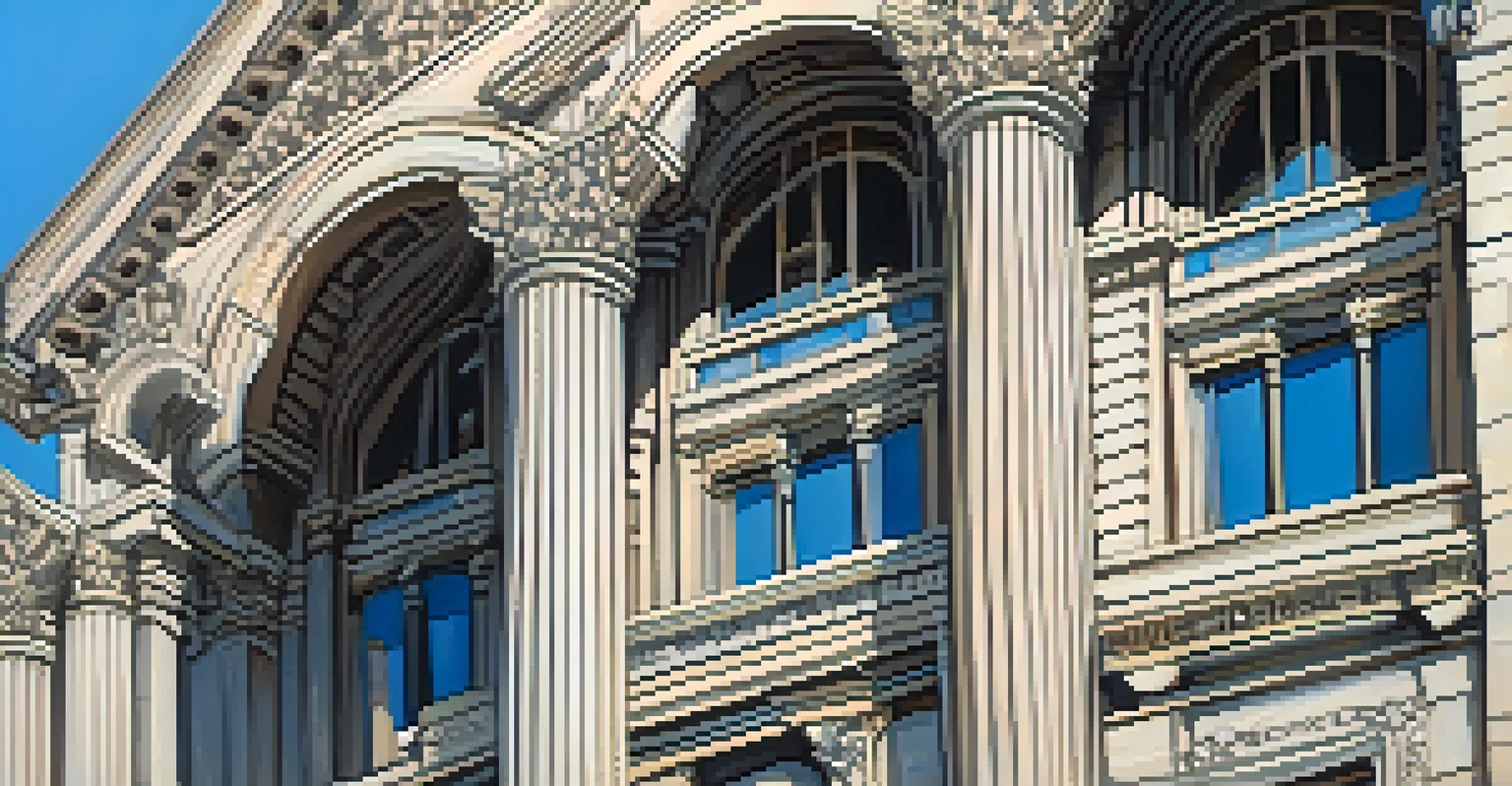Architecture of Minneapolis: A Journey Through Time

The Origins of Minneapolis Architecture: A Historical Overview
Minneapolis's architectural journey began in the mid-19th century, influenced by its booming lumber industry. The city's early structures featured utilitarian designs, reflecting the practical needs of a growing population. As the city expanded, so did its architectural ambitions, leading to a blend of styles that would define its skyline.
Architecture is the learned game, correct and magnificent, of forms assembled in the light.
The arrival of the railroad in the 1860s further fueled growth, bringing new ideas and styles from across the country. As a result, Minneapolis began to adopt elements of Romanesque and Gothic architecture, which became prominent in public buildings and churches. This period laid the groundwork for the diverse architectural landscape we see today.
Today, remnants of this early architecture can still be found, offering a glimpse into the city's past. Walking through the streets of Minneapolis, one can admire the intricate details of these historical buildings, each with a story to tell. This rich history serves as the foundation for the city’s evolving architectural narrative.
The Flour Power: Flour Mills and Their Architectural Impact
One cannot discuss Minneapolis architecture without mentioning its iconic flour mills. The city earned the nickname 'Mill City' in the late 19th century, becoming a hub for flour production due to its strategic location along the Mississippi River. These mills, many of which are now repurposed, showcase the industrial architectural style of the era.

The most notable among them is the Washburn A Mill, which stands as a testament to the city's industrial past. Its towering structure and bold lines embody the utilitarian aesthetic of the time while also highlighting the importance of flour milling in Minneapolis's economy. Visiting these sites today offers a unique perspective on how industry shaped the city's architectural identity.
Historical Roots of Minneapolis
Minneapolis's architectural journey reflects its growth from a lumber industry hub to a city showcasing a blend of historical styles.
As the city evolved, many of these mills were adapted for new uses, transitioning from industrial powerhouses to vibrant cultural spaces. This transformation illustrates how architecture can evolve while preserving historical significance. The blend of old and new in these spaces continues to attract both residents and tourists alike.
The Rise of the Skyscraper: A Modern Transformation
The skyline of Minneapolis took a dramatic turn in the late 20th century with the rise of skyscrapers. This architectural movement marked a shift toward modernism, characterized by sleek glass facades and innovative designs. The Wells Fargo Place, completed in 1990, stands tall as the tallest building in the city, showcasing the ambition of Minneapolis's architectural vision.
The architecture of a city is the architecture of its imagination.
Skyscrapers not only altered the visual landscape but also reflected the economic growth of the city. As businesses flourished, so did the need for office spaces that could accommodate a growing workforce. This era saw the emergence of iconic buildings like the IDS Center, which became a symbol of Minneapolis’s modernity and resilience.
The integration of green spaces and public art within these urban structures has also been an important aspect of Minneapolis's architectural evolution. Developers have increasingly focused on creating environments that promote community engagement, making the skyline not just a collection of buildings, but a vibrant hub of social interaction.
Historic Preservation: Balancing Old and New
As Minneapolis continues to grow, the challenge of preserving its architectural heritage remains a priority. Historic preservation efforts have aimed to protect significant buildings and neighborhoods, ensuring that the city's past is not forgotten amid modernization. Organizations like the Minneapolis Heritage Preservation Commission play a crucial role in this process.
These preservation initiatives often involve restoring and repurposing older buildings, breathing new life into them while maintaining their historical integrity. For example, the iconic Foshay Tower, once the tallest building in the city, has been transformed into a hotel while preserving its Art Deco charm. This balance between old and new is essential in retaining the character of Minneapolis.
Architectural Evolution and Preservation
The balance between preserving historical buildings and modern development is crucial for maintaining Minneapolis's unique architectural identity.
Moreover, such efforts foster a sense of community and identity among residents. By valuing their architectural heritage, Minneapolis residents can foster pride in their city's history, creating a rich tapestry that connects the past with the present. This commitment to preservation ensures that future generations can appreciate the architectural legacy that shapes their city.
Diversity in Design: Minneapolis's Eclectic Architectural Styles
Minneapolis is a melting pot of architectural styles, reflecting its diverse cultural influences. From the neoclassical designs of the Hennepin County Courthouse to the contemporary flair of the Guthrie Theater, the city showcases a wide range of aesthetics. This eclectic mix adds to the vibrancy of the urban landscape, making it a feast for the eyes.
One of the standout neighborhoods, Northeast Minneapolis, features a blend of Victorian homes and modern lofts, illustrating the city's ability to embrace different architectural narratives. The juxtaposition of styles creates a unique charm that attracts both residents and visitors. Walking through these neighborhoods, one can feel the stories embedded in each structure.
Furthermore, the emphasis on innovative design is evident in projects like the U.S. Bank Stadium, which redefined the concept of a sports arena. Its striking, modern design not only serves its functional purpose but also enhances the city’s architectural dialogue. This diversity in design reflects the city’s dynamic spirit and commitment to creativity.
Public Art and Architecture: A Collaborative Experience
Public art has become an integral part of Minneapolis's architectural identity, enriching the urban experience. Murals, sculptures, and installations can be found throughout the city, often enhancing the buildings and spaces around them. This collaboration between artists and architects fosters a sense of community and cultural expression.
One notable example is the Minneapolis Sculpture Garden, which integrates art seamlessly into the landscape. The iconic Spoonbridge and Cherry sculpture not only serves as a centerpiece but also highlights the relationship between nature and urban design. Such spaces encourage public interaction and create a vibrant atmosphere.
Future Innovations in Architecture
Minneapolis is embracing sustainability and smart technology in new architectural projects, shaping a dynamic urban landscape for the future.
The city’s commitment to public art reflects a broader understanding of architecture as more than just buildings. It emphasizes the importance of creating spaces that inspire, engage, and connect people. This holistic approach enhances the overall aesthetic and cultural fabric of Minneapolis, making it a city that values creativity in all its forms.
The Future of Minneapolis Architecture: Innovations on the Horizon
As Minneapolis looks to the future, innovative architectural practices are on the rise. Sustainability is becoming a key focus, with new developments prioritizing eco-friendly materials and designs. Projects like the Green Homes North initiative demonstrate how architecture can adapt to environmental challenges while creating livable spaces.
The integration of smart technology into building designs is another exciting trend. By incorporating advanced systems for energy efficiency and connectivity, architects are redefining what modern living looks like. This forward-thinking approach positions Minneapolis as a leader in sustainable urban development.

Moreover, community involvement in the architectural process is gaining traction, ensuring that new projects reflect the needs and desires of residents. This emphasis on collaboration fosters a sense of ownership and pride in new developments. As Minneapolis continues to evolve, its architectural landscape promises to be as dynamic and engaging as the city itself.